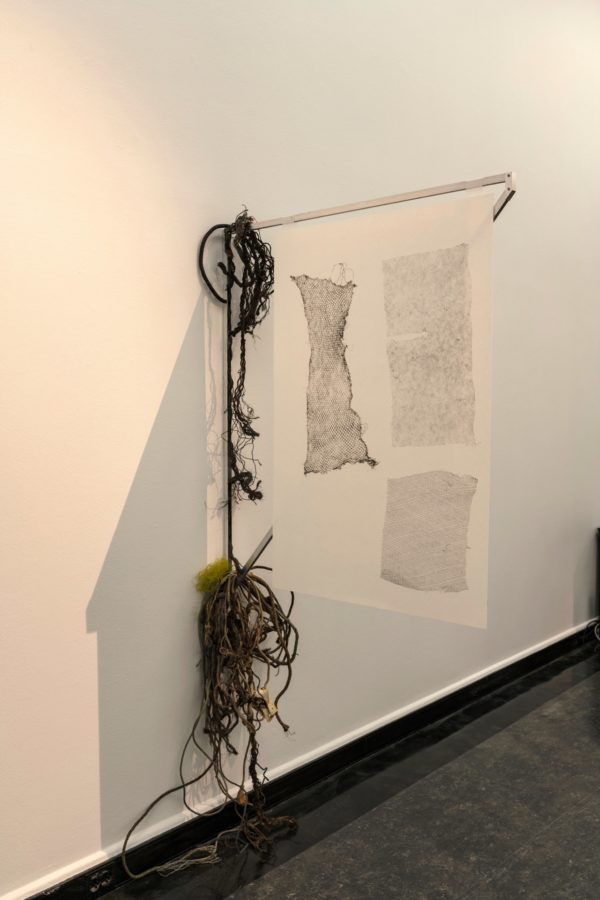“The mangrove is itself just such a place where the earth seems unearthly. It is here that human traces cannot survive as a lasting form, for this tropical coastal ecology is a site of continual refiguration: neither sea nor land, neither river nor sea, bearing neither salty nor fresh water, in neither daylight nor darkness.” (Natasha Ginwala and Vivian Ziherl, 2013)
Mngrv adds a new plant species to the botanical sciences. Mngrv emerged in South and South East Asia, where mangroves’ rhizomatic roots, always exposed to the rhythm of the tides, get entangled with fishnets, plastic waste, and oil remnants. Mngrv explores how in times of climate change and environmental pollution the borders between nature and culture, plant and plastic, increasingly blur. Susanne Kriemann imprinted the photographs she took during field research in Sri Lanka and Indonesia with the plastic waste she found on location, using a chunk of raw oil picked in the water as her pigment. Neither rope nor root, nylon nor plant, Mngrv is a material witness to the intertidal processes. Moreover, these processes in turn are shaped by the forces of capitalism, colonialism, and petroculture of which Kriemann and anyone engaging with the work are inevitably part as well. The work thus has a circular nature: Kriemann brings plastic waste found in Indonesia and Sri Lanka back to the EU, where much of it came from in the first place, and returns funding to the mangrove movement Desa Wisata Pengudang of Bintan, Indonesia to support their efforts and collaborations.
References
...- THE PLASTICITY OF TIME by Susanne Kriemann and Ruby de Vos. In: Kunstlicht, "THE WORLDLINESS OF OIL", VOL. 42 NO 3/4, 2021, pp. 69–77.
- "From Here, Any Now, Mngrv" by Susanne Kriemann. In: Ute Meta Bauer (ed.), Climates. Habitats. Environments., MIT Press, 2022
- "Together", Trigger
- "Berührung", edited by Carolin Meister, Kristin Marek, Fink Verlag
- "Climates. Habitats. Environments.", edited by Ute Meta Bauer, MIT Press
Solo Exhibitions
...- Fotografien Neu Ordnen: Gestrüpp, 2020/2021 Museum für Kunst und Gewerbe Hamburg Curated by: Esther Ruelfs
- Mngrv, 2020 Galerie Block C Curated by: Ruby de Vos
Group Exhibitions
...- Image Ecology, 2023 C/o Berlin Curated by: Boaz Levin
- Grünzeug, 2023 Berlinische Galeria Curated by: Katja Reich
- Takeover, 2021 / 2022 Gropius Bau Curated by: 8. Grundschule, Pankow, Julia Moritz, Jennifer Streter
- Maps of Disquiet, 2021 / 2022 CHENNAI PHOTO BIENNALE – EDITION III Curated by: Arko Datto, Boaz Levin, Kerstin Meincke and Bhooma Padmanabhan
- Beuys Open Source, 2021 / 2022 Belmacz Curated by: Julia Muggenburg
- The Ocean, 2021 Kunsthall Bergen Curated by: Axel Wieder
- The Ghost Ship and the Sea Change, 2021 Gothenburg Internationale Biennale for Contemporary Arts Curated by: Lisa Rosendahl
- Fragile Times / Zerbrechliche Zeiten, 2020 Galerie im Körnerpark Curated by: Curated by Dorothee Bienert, Kati Kivinen

































